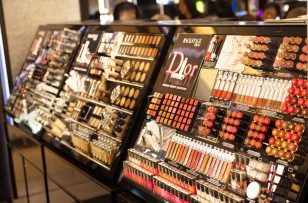The UK beauty industry is in the pink. Employing more than one million people and worth £17 billion, it is forecast to grow 16 per cent by 2016. Despite the recession, retail sales in the UK beauty market grew 15.5 per cent from £6.1 billion in 2008 to an estimated £7.1 billion in 2013.
“The beauty industry needs to be recognised for its economic contribution,” says Caroline Neville, president of industry body Cosmetic Executive Women (CEW). “Many men discount its worth, but when I go on to CNBC and CNN to talk about the value of the industry, they take it seriously because the Estée Lauder and L’Oréal share prices are flashing up behind me. The numbers speak for themselves.”

CEW president Caroline Neville with UK chancellor George Osborne at a reception at No 11 Downing Street, October 2014
To raise the profile of the British beauty industry, which has for too long been the sidelined sister to flamboyant fashion, CEW last year hosted a reception at the House of Commons for 140 MPs, peers and industry leaders. Even the Financial Times took note. But who at Westminster is really championing the beauty economy?
The £26-billion British fashion industry has London Mayor Boris Johnson popping up to support the men’s collection and Prime Minister’s wife Samantha Cameron, in her role as an official ambassador for the British Fashion Council, hosts high-profile receptions for fashion leaders at No 10. Where does beauty stand amid this fashion love-in?
Perhaps the tide is turning. In July Graeme Riddick, chief executive of the Quantum Beauty Company, was invited, with other business leaders, for talks with Chancellor George Osborne on steps to boost export, investment and growth. “I always thought beauty was seen as a poor relation to other UK companies, but the Chancellor is on an export drive,” Mr Riddick says.
Recession proof
With UK exports for cosmetic products growing about 5 per cent every year, beauty has been recession proof. “Women were trying to make themselves look and feel better while trying to hold on to their job or find a new one,” says Vivienne Rudd, Mintel’s director of global insight and innovation, beauty and personal care. “At the beginning, many assumed that the whole market would suffer, especially premium, but it held up well.”
Some small business even thrived. “We rolled out Elemental Herbology in September 2008 in the same week Lehman Brothers collapsed,” says Kristy Cimesa, founder of the skincare brand. “We succeeded because we were at a reasonable price-point and have grown each year 20 to 30 per cent. But had we gone in with expensive products, we wouldn’t still be here.”
Banks are interested again in offering financial support. “This industry is extremely important to us,” says Carol Bagnald, HSBC’s regional commercial director London. “We see a lot of businesses with terrific growth opportunities and many that have demonstrated this both in the UK and internationally. The global reach is growing at a real pace.”
Big business
The global cosmetic conglomerates are also showing healthy returns. L’Oréal in 2013 saw a global increase in sales of 5 per cent over its 28 brands which include Lancôme and Garnier. Estée Lauder, the owners of Clinique and MAC as well as many other brands, showed it doubled profits in its latest results.
Indeed, the worldwide beauty industry was last year valued at £300 billion, which is predicted to grow 29 per cent to £388 billion by 2017, according to CEW.
During the recession, the big winner was nail polish because it was at an accessible price-point, throwaway beauty in a way
UK consumers spent £8.9 billion on beauty and personal care products in 2013, excluding services such as hairdressing and spa treatments, with sales forecast by Mintel to hit £10 billion by 2017.
Premium make-up is the fastest growing sector, up 11 per cent in 2013, according to Imogen Matthews, author of The Premium Market Report. Yet 44 per cent of women find cheaper products effective, giving discount stores, such as Aldi, a 17 per cent boost in beauty sales.
Price does matter. “During the recession, the big winner was nail polish because it was at an accessible price-point, throwaway beauty in a way,” says Ms Rudd, with Mintel reporting 30 per cent of women use nail polish and nail bars.

The grey pound is stronger than ever with the 50-plus population predicted to grow by 38 per cent from 2015 to 2035. “Women over 45 spend £2 billion annually on cosmetics, skincare and toiletries, a figure that is growing faster than premium beauty,” Ms Matthews points out.
But products aside, is enough being done to support education and training on the home-front of the service sector? “I sit on parliamentary committees because, in the eyes of men, they don’t realise the importance of the beauty business,” says Eileen Cavalier, chief executive and founder or the London College of Beauty Therapy, which has trained 24,000 beauty therapists since 1995. “The great thing about the industry is that, for people from the ages of sixteen to sixty, there are jobs available.”
Increasing job vacancies, profits and exports? It can only be a matter of time until Westminster really wakes up and smells the nail polish.

Recession proof

